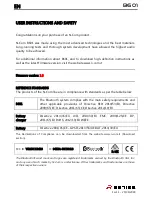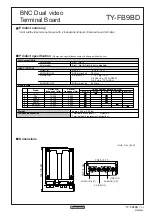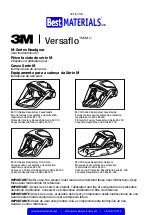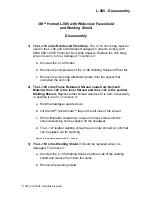
und eine Gefährdung Ihrer persönlichen Gesundheit. Weitere Informationen zur vorschriftsgemäßen Entsorgung des
alten Gerätes erhalten Sie bei der Stadtverwaltung, beim Entsorgungsamt oder in dem Geschäft, wo Sie das Produkt
erworben haben. Denken Sie an den Umweltschutz.
7. Reinigung und Lagerung:
Um das Licht zu reinigen verwenden Sie bitte nur ein feuchtes Tuch. Reinigungsmittel oder sonstige Chemikalien
können das Produkt beschädigen. Die Batterie darf nicht übermäßiger Wärme wie Sonnenschein, Feuer oder
dergleichen ausgesetzt werden. Bei unsachgemäßem Gebrauch besteht Explosionsgefahr.
EN
1. Safety instructions:
The LED light does not replace the lighting equipment specified for bicycles by the German Road Traffic Licencing
Act (sec. 67). Please use the LED light only in combination with this bicycle helmet and do not remove it. The rear
LED light is only intended for private use. Please note that the LED light may be covered up or not visible when using
collars or rucksacks or due to head movements. The LEDs cannot be replaced. If there is a defect, it will therefore be
necessary to dispose of the entire light (helmet). The rechargeable battery (lithium-ion battery) cannot be replaced.
2. Operation:
The light is turned on and off by briefly (< 1 sec.) pressing the button (Fig. 1), and it offers multiple function levels (Fig.
3-5). When the button is pushed the first time, the light turns on and shines steadily. When the button is pushed a
second time, the light changes to blinking mode (3 Hz). When the button is pushed a third time, the light changes to
pulsing mode (switching on and off at regular intervals). When the button is held down longer (> 2 sec.) (Fig. 6), the
light will be switched off from any mode. The status of the
battery charge is shown for 3 seconds by a status LED
(Fig. 7) when the LED light is switched on or off.
Status LED green
60% - 100% battery charge
Status LED green/red
30% - 60% battery charge
Status LED red
less than 30% battery charge
3. Charging the battery:
In order to charge the battery, look at Figures 8 to 12, which illustrate how to charge the battery. With the PIL-5 the
micro USB connector is located on the outside of the light. First open the micro USB cover (Fig. 8) of the light by
carefully lifting up the micro USB cover. You will then be able to move the micro USB cover to the side and see the
micro USB connection (Fig. 9). You can plug in the supplied USB charging cable (Fig. 2) here by lining up the poles
correctly (Fig. 10 & 11) and charge the battery using a conventional USB charger (5 V – 2 mA). The charging status
will be indicated by the status LED (Fig. 12).
Status LED blinking red
less than 30% battery charge
Status LED blinking green/red
30% - 60% battery charge
Status LED blinking green
60% - 95% battery charge
Status LED steady green
more than 95% fully charged
Carry out the steps in the reverse order when charging is finished. Make sure that the micro USB cover (Fig. 1)
correctly clicks into place in the opening provided for it.
The lighting time with a fully charged battery is approx. 6 hours for a steady light and at most 12 hours for a blinking
light.
4. ATTENTION:
Please note that the battery of the LED light may fail or become discharged.
For this reason, check regularly to make sure that the light is functional. Parents should take care to ensure that their
child as well regularly checks that the LED light is working. The LED light is not a toy and may only be used by children
while under the supervision of adults.
5. Symbols on the helmet and plug-in:
You can find the following wording/symbols on the helmet and plug-in. (Fig. 13 - 17)
•
Fig. 13: PIL-5 model name: This ensures proper identification of the product.
•
Fig. 14: CE mark: Products labelled with this symbol meet the requirements of the CE guidelines.
•
Fig. 15: Rubbish bin: It is not permissible to dispose of the product in household rubbish; instead, it must be
brought to a municipal collecting point or recycling centre.
•
Fig. 16: Rubbish bin: The rechargeable battery (lithium-ion battery) cannot be replaced.
•
Fig. 17: IP44 protection class: The IP protection classes establish the extent to which an electrical component
can be exposed to environmental influences without being damaged or constituting a safety risk. The protection
class of this light is IP 44, which means that it is protected against solid foreign bodies 1.0 mm in diameter and
larger. It affords protection against splashing water.
•
Fig. 18: Power supply: Li-ion 3.6 V; 180 mAh.
6. Instructions and disposal:
It is only permissible for adults to charge the light. Always insert the micro USB plug with the poles lined up correctly
(Fig. 10 & 11). Do not attempt to remove the housing (Fig. 1), and by no means should the device be thrown into a
fire. There is danger of the battery exploding or leaking if used improperly. Leaking or damaged batteries may cause
chemical burns if they touch the skin. You should therefore be sure to wear suitable gloves in such cases. Please
note that it is not permissible to dispose of batteries in household rubbish (Fig. 15); instead, they must be brought to
Summary of Contents for PLUG-IN-LIGHT V HAGA LED
Page 1: ...PLUG IN LIGHT V HAGA LED ...






























